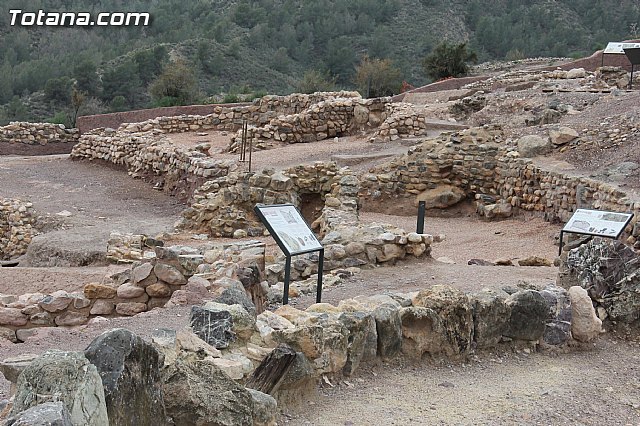The Mayor of Totana, Isabel Maria Sanchez, will raise a motion at the next regular full to ask the Ministry of Culture and Tourism urgently initiate the procedure for processing to request one percent culture to the Ministry of Education, Culture Sport and aimed to strengthen the financial Argárico Reservoir in La Bastida Totana.
Given the magnitude of the findings in La Bastida action is needed restoration and consolidation allowing them first, the recovery and conservation of this finding and second, the promotion of historical and artistic heritage and cultural Totana, objective priority for the region of Murcia and the City of Totana.
Rich heritage and culture
The site of La Bastida is 6 kilometers northwest of the town, in the Vines-Carivete, and occupies a steep hill at the confluence between the boardwalk and the Barranco Lébor Salado.
La Bastida was the first settlement argárico researched and published monograph (1869).
Currently, one of the most important European prehistory, namely the so-called Bronze Age.
The territory of the Region of Murcia was part of the nuclear focus argárica society, from where it spread throughout the inland peninsular Southeast to configure probably one of the first states of the Old World.
La Bastida was the political and economic center highlight of the heyday of argárica society, reaching back then the special status of the city center.
The richness and variety of archaeological finds (metallurgy of copper, bronze, silver and gold; specialized pottery, stone tools and ornaments and bone), the complex urban fabric of its towns, social and ritual significance of its abundant funerary contexts and the novelty of its economic and political organization have placed in the center of prehistoric research since the late nineteenth century.
Since its discovery and first excavations by the engineer Granada D.
Inchaurrandieta Rogelio in 1869, the site has undergone several archaeological digs.
The works, which continue today, show a real city of about 40,000 m2, at its peak time, 3800 years ago, was inhabited by about 1000 people.
The deposit is held by the Governing Council of the Autonomous Region in 2005, as a Cultural of the special significance of the site and the need to protect their important historical and archaeological value.
Archeological excavations in the spring-summer of 2012 at the archaeological site of La Bastida have unearthed a massive fortification system unique in its time.
The finding confirms, along with the other discoveries made in recent years, the city was the most developed European settlement in political and military terms during the Bronze Age (4,200 years ago BC-2200) only comparable with the Minoan civilization Crete.
The fortification consisted of a wall of 2-3 feet thick, built of large stones with mortar locked and reinforced by massive towers distributed truncated pyramidal little apart and about 4 feet square.
The original height of the defense complex would be about 6 or 7 meters.
So far we have discovered six towers along a stretch of 70 meters, although the perimeter of the fort would have reached the 300 meters.
The entrance to the site was via a corridor flanked by thick walls, with gates that would be closed wedged between thick wooden posts.
One of the most important architectural elements that have been discovered is a pointed arch that crowns a postern, or side door, next to the entrance.
The arch has been preserved and is completely unprecedented in European prehistory.
His record is found in the second city of Troy (Turkey) and in the urban world of the Middle East (Palestine, Israel and Jordan), influenced by the civilizations of Mesopotamia and Egypt.
This would indicate the participation of people from East in its construction.
It was only between 400 and 800 years for civilizations such as Hittite and Mycenaean or large Mediterranean city-states as Ugarit adopt this innovation in military architecture.
Fortification of La Bastida impresses by its size, by the knowledge of architecture and engineering exhibits, because of its age and because it helps to know a past so remote in time as recognizable in the present.
It also involves an innovation in the art of attack and defense fortifications, military specifically.
It was a work designed exclusively by and for combat, by persons in a lides bregadas hitherto unknown in the West.
The postern as hidden and covered require access for engagement in the wall prior planning of the whole defense and engineering knowledge appropriate to do so.
The findings reveal a break La Bastida military, political and social: the establishment of a violent power and class, which lasted for seven centuries and that affected the development of communities in the rest of the peninsula.
Overall, rethinking what is known about the origin of the economic and political inequalities in Europe, the formation of the military and the role of violence in shaping identity traditions.


